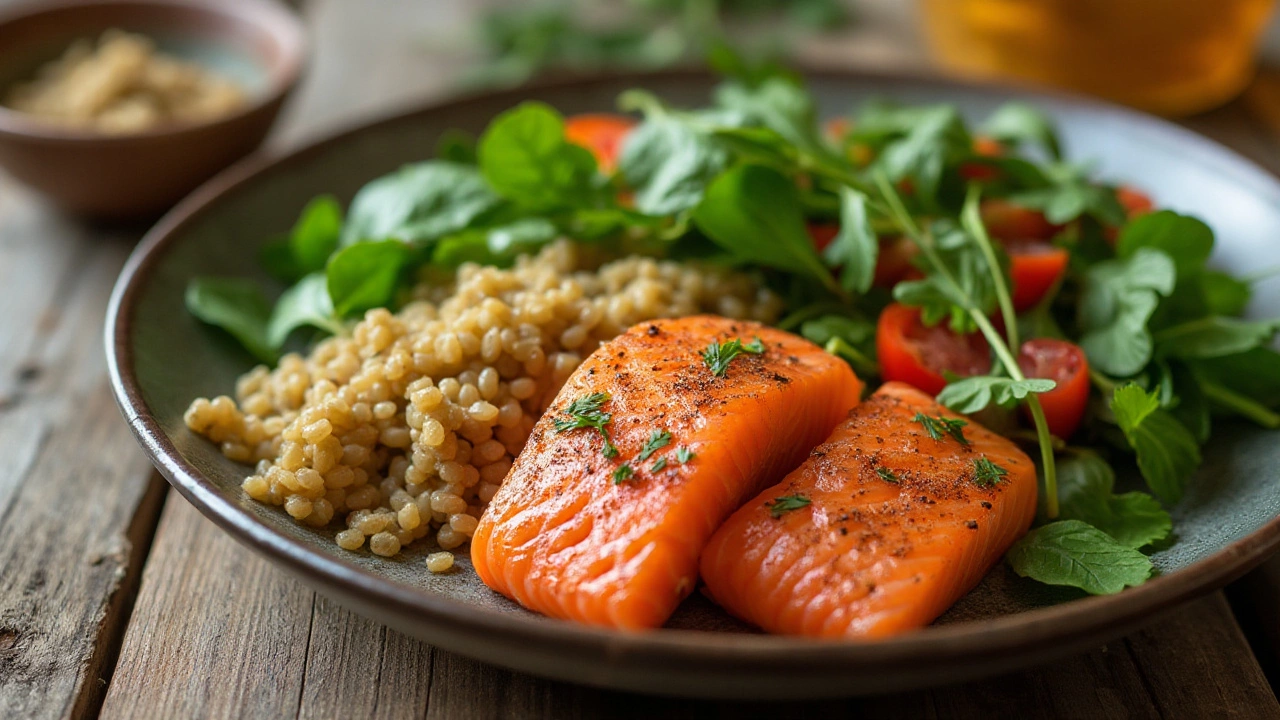
Sculpting a trimmer waistline is more than just an aesthetic pursuit; shedding belly fat can significantly enhance your overall health and vitality. Many people find themselves frustrated by a stubborn midsection, often unsure of the best tactics to wave it goodbye. While it's impossible to reduce fat from just one area, engaging in specific workouts can help you hone in on your belly fat goals.
Commonly, people believe that crunches and sit-ups alone will offer them a flat stomach. However, these exercises are just part of the puzzle. A blend of cardio, strength training, and attention to diet can turbocharge your progress. Let’s delve into effective strategies and exercises that can aid in achieving the ultimate waist-whittling results.
- Understanding Belly Fat
- Exercises to Target Belly Fat
- Debunking Spot Reduction Myths
- Diet and Lifestyle Tips
Understanding Belly Fat
When we talk about belly fat, we're not just focusing on the aesthetic bulge that peeks over waistbands but also the deeper, more worrisome visceral fat. Unlike subcutaneous fat, which lies just beneath the skin, visceral fat loves to snuggle up to the organs deep in your abdomen. This proximity isn’t just cozy—it’s potentially dangerous, linking increased visceral fat with serious health issues like heart disease and type 2 diabetes. It's essential to know that our belly fat isn't just stubborn because of an affinity for pastries. Genetics, lifestyle choices, and even stress levels all team up to determine its persistence.
Many people believe that if belly fat were its own character in our bodies’ life story, it'd be the villain. But it’s crucial to understand this fat also has roles like protecting internal organs from impacts. Still, too much of it, and the scales tip from protective to perilous. Age is another factor that controls how fat accumulates, with our metabolism seemingly slowing down and allowing this fat to sink its claws in deeper as the years march on. Moreover, hormonal changes, particularly in women during menopause, can signal the body to shift fat storage from the hips and thighs up to the midsection.
There's also talk about how stress plays matchmaker in this fat accumulation process. Chronic stress can urge the body to hang onto fat as it pumps out cortisol, the stress hormone, which is known to encourage fat storage as a defense mechanism. Industry experts, like Dr. Robert Lustig, have pointed out the impact of sugar and processed foods in compounding this issue through both small indulgent choices and larger dietary patterns that favor quick satisfaction over long-term wellness.
"We are literally putting our heads in the sand when it comes to understanding what sugar is doing to our body and our belly fat," warns Dr. Lustig, stressing the importance of holistic lifestyle changes over short-term diet fads.
To those striving to tame their waistlines, it’s heartening to note that belly fat often responds well to cohesive and consistent efforts. While spot reduction might seem like a tempting shortcut, it’s a fitness myth that only leads to disappointment. Engaging the whole body through a combination of cardio and strength training, paired with balanced nutrition, is a far more rewarding path. As we navigate through daily stresses and temptations, knowledge really becomes our ally. Recognizing the factors at play helps empower individual action and choice, ultimately guiding us toward healthier lifestyles less dictated by the whims of belly fat.

Exercises to Target Belly Fat
When it comes to targeting belly fat, there are a variety of exercises that can help you zero in on this challenging area. Engaging in full-body workouts, rather than localized ones, can often produce more effective results. A balanced blend of aerobic activities and strength training is quintessential for achieving a leaner belly. Cardio exercises like brisk walking, jogging, and cycling are fantastic for elevating your heart rate and burning calories. These workouts, when combined with resistance training, create a powerful impact that encourages your body to burn fat even at rest. Incorporate planks into your routine, as they work wonders to stabilize the core while engaging multiple muscle areas. As you progress, challenge yourself by upping the duration or complexity of these exercises.
Strength training plays a crucial role in muscle building, which is imperative for increasing the resting metabolic rate. When the body has more muscle, it burns more energy even when you're not moving around. Compound movements such as squats and lunges activate significant muscle groups, boosting muscle growth and contributing to overall fat burning. One effective exercise that specifically targets the core is the Russian twist. This dynamic movement encourages the activation of core muscles, enhancing endurance and strength. Remember, the consistency of your workout regimen often influences how rapidly you see results.
High-Intensity Interval Training, or HIIT, is another robust method for accelerating fat loss. The beauty of HIIT lies in its ability to intertwine short bursts of maximum effort activity with brief periods of rest or lower-intensity exercises. This structure keeps your body in a state of high energy consumption, long after the workout has ended. Try exercises like burpees and mountain climbers, which engage the core and increase your heart rate simultaneously. Adjusting your rest periods can easily modify the intensity of these exercises. A fun fact: a study published in the Journal of Obesity indicated that individuals who incorporated HIIT saw a more significant reduction in belly fat compared to those who stuck with steady-state cardio alone.
"Consistency will always surpass sporadic bursts of effort when it comes to building habits that last," says fitness coach Jillian Michaels. "It's the regularity of your regime that solidifies lifestyle changes."
Don't forget the role of stretching and flexibility exercises. Many often overlook the importance of activities like yoga or pilates, which can help tone and strengthen the core, integrating flexibility with strength. These exercises focus deeply on the midsection and enhance balance and posture, which can be crucial for maintaining a flat and strong core. Building a consistent routine that includes a mix of these exercises could significantly aid in reducing belly fat, promoting both fitness and health goals. Commit to continuous improvement, and you'll likely notice not just physical changes, but boosts in energy and mental well-being as well. Now, let's lace up those sneakers and get moving toward a trimmer, healthier you!

Debunking Spot Reduction Myths
The idea of spot reduction, the notion that you can lose fat in just one specific area by exercising that body part, is an enduring myth that needs to be unraveled. Despite its widespread popularity, science tells us a different story. Our body decides where it sheds fat based on genetics and overall weight loss efforts, not by focusing exercises on one body part. Multiple studies have illustrated that targeted exercises, like endless crunches, won't magically melt away belly fat. Instead, these exercises should be seen as muscle-strengthening activities that tone the area beneath the fat layer.
In one insightful study, researchers found that participants who engaged in various abdominal exercises for six weeks showed no significant reduction in abdominal fat compared to those who did not. This underscores the fact that while exercises are vital for core strengthening, belly fat loss stems from a holistic approach involving full-body workouts and nutritional choices. Instead of targeting belly fat, a well-rounded routine, including cardiovascular exercises such as running or cycling, is much more effective in promoting overall fat loss, which eventually impacts stubborn areas.
The persistent belief in spot reduction is partly due to the visible gain in muscle tone when we exercise a particular area. As muscles firm up, they may give the deceptive appearance of a slimmer profile, even if the fat layer above remains unchanged. Addressing weight loss with a comprehensive strategy involves combining varied exercise routines with careful attention to dietary habits. The body doesn't interpret crunches as a cue to use up the fat around the belly; instead, it uses energy stored throughout the body equitably.
"If you spend an hour a day doing cardio and ignore your diet, you're only tackling a portion of the problem," states Dr. John Smith, a fitness expert. "Effective fat loss happens primarily in the kitchen where you control your calorie intake and nutrient balance."The myth of spot reduction continues to persist despite overwhelming evidence against it. As fitness enthusiasts, embracing this reality not only saves us from disappointments but also guides us towards more effective strategies built on scientifically proven methods. Adopting a realistic plan that includes both varied exercise and mindful eating habits is key to conquering belly fat and achieving lasting health rewards.

Diet and Lifestyle Tips
Changing your eating habits and lifestyle choices can be key to losing that stubborn belly fat. It's often said that abs are made in the kitchen, and there's a lot of truth to that. Eating a balanced diet that focuses on whole, unprocessed foods is one of the most effective ways to shed those extra inches around your waist. Instead of reaching for sugary snacks or fast food, try filling your plate with fruits, vegetables, lean proteins, and healthy fats. These foods provide your body with necessary nutrients and often help you feel fuller for longer, reducing the urge to snack on less healthy options.
Hydration is another critical factor that's often overlooked. Drinking plenty of water not only keeps you hydrated but also helps with digestion and can prevent you from mistaken thirst for hunger. A good rule of thumb is to drink at least eight glasses of water a day, but this can vary depending on your activity level and needs. An interesting study from the Journal of Clinical Endocrinology & Metabolism found that drinking water can boost your metabolism by up to 30% for a few hours.
"Our findings suggest that drinking 500 ml of water increases metabolic rate by 25% to 30% for about 30-40 minutes," reported Dr. Michael Boschmann, a physiologist at the Franz-Volhard Clinical Research Center in Berlin.
In addition to diet, sleep and stress management play crucial roles in belly fat reduction. Lack of sleep can disrupt hormones like cortisol and increase the risk of gaining weight around your belly. Seven to nine hours per night is typically recommended for adults. Meanwhile, stress triggers hormone release that can result in increased appetite and cravings for unhealthy food, making it essential to practice relaxation techniques like meditation, yoga, or even deep breathing exercises. Prioritizing these aspects of your lifestyle can form a strong foundation for a healthier body and mind.
For many, bringing structure into eating habits and lifestyle can be challenging at first, but creating small, manageable goals such as introducing one new healthy meal or snack into your diet each week can make the transition smoother. It's also beneficial to keep track of your progress through a food and exercise journal. There, you can jot down what you eat and how you feel throughout the day, which can pinpoint areas where you might need to make additional changes. Reducing consumption of alcohol, which is not only calorie-dense but also slows down the fat-burning process, could also support your weight loss efforts.
Finally, understanding the role genetics play can help manage expectations. While lifestyle changes certainly impact how much belly fat you might lose, genetic factors can influence fat distribution. This means being kind to yourself and measuring success by how you feel and function rather than just by the numbers on a scale. By combining diet changes with other healthy habits, you'll be well on your way to a fitter, happier you.
